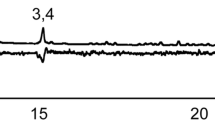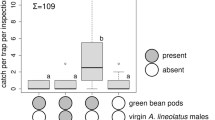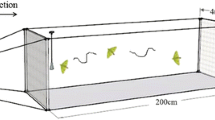Abstract
The guava fruit fly, Anastrepha striata, is a pest of several cultivated species of Myrtaceae in the American tropics and subtropics. During calling, A. striata males release numerous volatiles. This study was conducted to identify which of the male volatiles function as the A. striata sex pheromone and to investigate the effects of age and time of day on the emission of pheromone components. Analysis of the volatiles from males collected by solid phase microextraction using gas chromatography coupled to electroantennographic detection (GC-EAD) showed that three volatile compounds elicited repeatable responses from the antennae of females. The EAD-active compounds were identified by GC/mass spectrometry as ethyl hexanoate, linalool, and ethyl octanoate. In two-choice tests using Multilure traps placed in field cages, traps baited with live males, ethyl hexanoate, or the three-component blend captured more females than unbaited traps. However, there was no difference in catches when traps baited with live males were compared against traps baited with ethyl hexanoate. Although traps baited with the three-component blend caught more females than traps baited with live males, the difference was not significant. Analyses of pheromonal components released by A. striata males 8 to 26 days old showed that there was an effect of age on pheromone production and also a significant effect of time of day on pheromone emission. Release of the volatile compounds occurred from 14.00 to 18.00 hr, although traces of linalool were detected from 08.00 hr. Peak emission of pheromone compounds occurred at 14.00 hr.






Similar content being viewed by others
References
Aluja M, Birke A (1993) Habitat use by adults of Anastrepha obliqua (Diptera: Tephritidae) in a mixed mango and tropical plum orchard. Ann Entomol Soc Am 86:799–812
Aluja M, Jacome I, Birke A, Lozada N, Quintero G (1993) Basic patterns of behavior in wild Anastrepha striata (Diptera:Tephitidae) flies under field-cage conditions. Ann Entomol Soc Am 86:776–793
Aluja M, Piñero J, Jácome I, Díaz-Fleischer F, Sivinski J (2000) Behavior of flies in the genus: Anastrepha (Trypetinae: Toxotrypanini). In: Aluja M, Norrbom AL (eds) Fruit flies (Tephritidae): Phylogeny and evolution of behavior. CRC Press LLC, Boca Raton, pp 375–406
Arita LH, Kaneshiro KY (1986) Structure and function of the rectal epithelium and anal glands during mating behavior in the Mediterranean fruit fly. Proc Hawaiian Entomol Soc 26:27–30
Arn H, Städler E, Rauscher S (1975) The electroantennographic detector a selective and sensitive tool in the gas chromatographic analysis of insect pheromones. Z Naturforsch 30c:722–725
Břízová R, Mendonça AL, Vanícková L, Mendonça AL, Da Silva CE, Tómala A, Paranhos BA, Dias VS, Joachim-Bravo IS, Hoskovec M, Kalinová B, Do Nascimento RR (2013) Pheromone analyses of the Anastrepha fraterculus (Diptera: Tephritidae) cryptic species complex. Fla Entomol 96:1107–1115
Chuman T, Siviniski J, Heath RR, Calkins CO, Tumilson JH, Batiste MA, Wydra RL, Strekowski L, Nation JL (1988) Suspensolide a new macrolide component of male Caribbean fruit fly (Anastrepha suspensa) volatiles. Tetrahedron Lett 29:6561–6564
Cruz-López L, Malo EA, Toledo J, Virgen A, del Mazo A, Rojas JC (2006) A new potential attractant for Anastrepha obliqua from Spondias mombin fruits. J Chem Ecol 32:351–365
Díaz Santis E (2014). Respuesta olfativa de Anastrepha striata Schiner (Diptera:Tephritidae) a volátiles de frutos Psidium guajava y Citrus sinensis, El Colegio de la Frontera Sur, Tapachula, Chiapas, Mexico. Thesis
Foote RH, Blanc FL, Norrbom AL (1993) Handbook of the fruit flies (Diptera: Tephritidae) of America north of Mexico. Comstock, USA
Gonçalves GB, Silva CE, De Lima MA, Vaníčková L, Tomčala A, Do Nascimento RR (2013) Pheromone communication in Anastrepha obliqua (Diptera: Tephritidae): a comparison of the volatiles and salivary gland extracts of two wild populations. Fla Entomol 96:1365–1374
Heath RR, Landolt PJ, Robacker DC, Dueben BD, Epsky N (2000) Sexual pheromones of tephritid flies: clues to unravel phylogeny and behavior. In: Aluja M, Norrbom AL (eds) Fruit flies (Tephritidae): Phylogeny and evolution of behavior. CRC Press LLC, Boca Raton, pp 793–809
Henning F, Matioli SR (2006) Mating time of the West Indian fruit fly Anastrepha obliqua (Macquart) (Diptera: Tephritidae) under laboratory conditions. Neotrop Entomol 35:145–148
Ibáñez-López A, Cruz-López L (2001) Glándulas salivales de Anastrepha obliqua (Macquart) (Diptera: Tephritidae): Análisis químico y morfológico, y actividad biológica de los componentes volátiles. Folia Entomol Mex 40:221–231
López-Guillen G, Malo EA, Rojas JC (2011) Olfactory responses of Anastrepha obliqua (Diptera: Tephritidae) to volatiles emitted by calling males. Fla Entomol 94:874–880
Malo EA, Cruz-López L, Toledo J, Del Mazo A, Virgen A, Rojas JC (2005) Behavioral and electrophysiological responses of the Mexican fruit fly (Diptera: Tephritidae) to guava volatiles. Fla Entomol 88:364–371
Nation JL (1975) The sex pheromone blend of Caribbean fruit fly males: isolation biological activity, and partial chemical characterization. Environ Entomol 4:27–30
Nation JL (1989) The role of pheromones in the mating system of Anastrepha fruit flies. In: Robinson AS, Hooper G (eds) World Crop Pests, Vol. 3A: Fruit flies, their biology, natural enemies and control. Elsevier, Amsterdam, pp 189–205
Norrbom AL (2001) Anastrepha striata Schiner. The Diptera site.http://www.sel.barc.usda.gov/diptera/tephriti/Anastrep/striata.htm (January 19, 2002)
Norrbom AL, Zucchi RA, Hernández-Ortiz V (2000) Phylogeny of the genera Anastrepha and Toxtrypana (Trypetinae: Toxotrypanini) based on morphology. In: Aluja M, Norrbom AL (eds) Fruit flies (Tephritidae): Phylogeny and evolution of behavior. CRC Press, Boca Raton, pp 299–342
Robacker DC (1988) Behavioral responses of female Mexican fruit flies, Anastrepha ludens, to components of male-produced sex pheromone. J Chem Ecol 14:1715–1726
Robacker DC, Aluja M, Cosse AA, Sacchetti P (2009) Sex pheromone investigation of Anastrepha serpentina (Diptera: Tephritidae). Ann Entomol Soc Am 102:560–566
Rocca JR, Nation JL, Strekowski L, Battiste MA (1992) Comparison of volatiles emitted by male Caribbean and Mexican fruit flies. J Chem Ecol 18:223–244
Acknowledgments
We are grateful for the statistical advice of Javier Valle-Mora (ECOSUR). We thank E. Hernández-Ortiz (Subdirección de Desarrollo de Métodos. Moscamed-Moscafrut, Mexico) for providing the flies used in this study, and Antonio Santiesteban and Armando Virgen for technical support.
Author information
Authors and Affiliations
Corresponding author
Rights and permissions
About this article
Cite this article
Cruz-López, L., Malo, E.A. & Rojas, J.C. Sex Pheromone of Anastrepha striata . J Chem Ecol 41, 458–464 (2015). https://doi.org/10.1007/s10886-015-0581-y
Received:
Revised:
Accepted:
Published:
Issue Date:
DOI: https://doi.org/10.1007/s10886-015-0581-y




